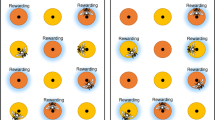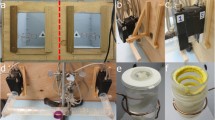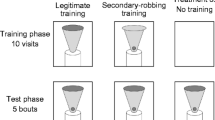Abstract
Foraging animals can acquire new information about food sources either individually or socially, but they can also opt to rely on information that they have already acquired, termed “personal information”. Although social information can provide an adaptive shortcut to new resources, recent theory predicts that investing too much time in acquiring new information can be detrimental. Here, we investigate whether foraging bumblebees (Bombus terrestris) strategically prioritize personal information unless there is evidence of environmental change. All bees in our study had personal information that one species of artificial flower was rewarding, and bees in the scent group then experienced social information about an alternative-scented species inside the nest, while a control group did not. On their next foraging bout, bees in both groups overwhelmingly used personal information when deciding where to forage. When bees subsequently learnt that the rewards offered by their preferred species had dwindled, bees that had social information were no quicker to abandon their personal information than control bees, but once they had sampled the alternative flowers, they showed greater commitment to that species than control bees. Thus, we found no evidence that social information is particularly important when personal information fails to produce rewards (a “copy when established behaviour is unproductive” strategy). Instead, bees used social information specifically to complement personal information.


Similar content being viewed by others
References
Boyd R, Richerson P (1985) Culture and the evolutionary process. University of Chicago Press, Chicago
Boyd R, Richerson P (1988) An evolutionary model of social learning: the effects of spatial and temporal variation. In: Zentall TR, Galef BG (eds) Social learning: psychological and biological perspectives. Lawrence Erlbaum Associates, Hillsdale, pp 29–48
Boyd R, Richerson P (1995) Why does culture increase human adaptability? Ethol Sociobiol 16:125–143
Chittka L, Thomson JD (eds) (2001) Cognitive ecology of pollination. Cambridge University Press, Cambridge
Couvillon MJ, Riddell Pearce FC, Harris-Jones EL, Kuepfer AM, Mackenzie-Smith sJ, Rozario LA, Schürch R, Ratnieks FLW (2012) Intra-dance variation among waggle runs and the design of efficient protocols for honey bee dance decoding. Biology Open. ISSN 2046-6390
Crawley MJ (2007) The R book. John Wiley & Sons, Ltd., Chichester
Czaczkes TJ, Grüter C, Jones SM, Ratnieks FLW (2011) Synergy between social and personal information increases foraging efficiency in ants. Biol Lett 7(4):521–524. doi:10.1098/rsbl.2011.0067
Dawson EH, Chittka L (2014) Bees use social information as an indicator of safety in dangerous environments. Proc Roy Soc B (in press)
Dawson EH, Avargues-Weber A, Chittka L, Leadbeater E (2013) Learning by observation emerges from simple associations in an insect model. Curr Biol 23:727–730
Dornhaus A, Chittka L (1999) Evolutionary origins of bee dances. Nature 401:38
Dornhaus A, Chittka L (2001) Food alert in bumblebees (Bombus terrestris): possible mechanisms and evolutionary implications. Behav Ecol Sociobiol 50(6):570–576
Dornhaus A, Chittka L (2004) Information flow and regulation of foraging activity in bumble bees (Bombus spp.). Apidologie 35(2):183–192
Enquist M, Eriksson K, Ghirlanda S (2007) Critical social learning: a solution to Rogers’s paradox of nonadaptive culture. Am Anthropol 109(4):727–234
Farina WM, Gruter C, Diaz PC (2005) Social learning of floral odours inside the honeybee hive. Proc R Soc Lond B 272(1575):1923–1928
Farina WM, Gruter C, Acosta L, Mc Cabe S (2007) Honeybees learn floral odors while receiving nectar from foragers within the hive. Naturwissenschaften 94(1):55–60
Frisch V (1967) The dance language and orientation of bees. Harvard University Press, Cambridge
Goulson D, Hawson SA, Stout JC (1998) Foraging bumblebees avoid flowers already visited by conspecifics or by other bumblebee species. Anim Behav 55:199–206
Grüter C, Ratnieks FLW (2011) Honeybee foragers increase the use of waggle dance information when personal information becomes unrewarding. Anim Behav 81(5):949–954. doi:10.1016/j.anbehav.2011.01.014
Grüter C, Balbuena MS, Farina WM (2008) Informational conflicts created by the waggle dance. Proc R Soc B 275:1321–1327
Grüter C, Leadbeater E, Ratnieks FLW (2010) Social learning: the importance of copying others. Curr Biol 20(16):R683–R685. doi:10.1016/j.cub.2010.06.052
Grüter C, Czaczkes TJ, Ratnieks FLW (2011) Decision making in ant foragers (Lasius niger) facing conflicting personal and social information. Behav Ecol Sociobiol 65(2):141–148. doi:10.1007/s00265-010-1020-2
Grüter C, Segers FHID, Ratnieks FLW (2013) Social learning strategies in honey bee foragers: do the costs of using personal information affect the use of social information? Anim Behav 85:1443–1449
Heinrich B (1979) Bumblebee economics. Harvard University Press, Cambridge
Heyes (1994) Social learning in animals: categories and mechanisms. Biol Rev 69:207–231
Hölldobler B, Wilson EO (1990) The ants. Springer-Verlag, Berlin Heidelberg
Kendal RL, Coolen I, Laland KN (2004) The role of conformity in foraging when personal and social information conflict. Behav Ecol 15(2):269–277
Kendal RL, Coolen I, van Bergen Y, Laland KN (2005) Trade-offs in the adaptive use of social and asocial learning. Adv Stud Behav 35:333–379
Kendal RL, Coolen I, Laland KN (2009) Adaptive trade-offs in the use of social and personal information. Cognitive ecology II
Laland KN (2004) Social learning strategies. Learn Behav 32(1):4–14
Leadbeater E, Chittka L (2005) A new mode of information transfer in foraging bumblebees? Curr Biol 15(12):R447–R448
Leadbeater E, Chittka L (2007a) Social learning in insects: from miniature brains to consensus building. Curr Biol 17(16):R703–R713
Leadbeater E, Chittka L (2007b) The dynamics of social learning in an insect model (Bombus terrestris). Behav Ecol Sociobiol 61:1789–1796
Molet M, Chittka L, Raine NE (2009) How floral odours are learned inside the bumblebee (Bombus terrestris) nest. Naturwissenschaften 96(2):213–219. doi:10.1007/s00114-008-0465-x
Rendell L, Boyd R, Cownden D, Enquist M, Eriksson K, Feldman MW, Fogarty L, Ghirlanda S, Lillicrap T, Laland KN (2010) Why copy others? Insights from the social learning strategies tournament. Science 328(5975):208–213. doi:10.1126/science.1184719
Rendell L, Fogarty L, Hoppitt W, Morgan T, Webster M, Laland K (2011) Cognitive culture: theoretical and empirical insights into social learning strategies. Trends Cogn Sci 15:68–76
Rieucau G, Giraldeau L-A (2011) Exploring the costs and benefits of social information use: an appraisal of current experimental evidence. Philos Trans R Soc B 366(1567):949–957. doi:10.1098/rstb.2010.0325
Rogers AR (1988) Does biology constrain culture? Am Anthropol 90(4):819–831
Seeley TD (1998) Thoughts on information and integration in honey bee colonies. Apidologie 29(1–2):67–80
Seeley TD, Visscher PK (1988) Assessing the benefits of co-operation in honeybee foraging- search costs, forage quality and competitive ability. Behav Ecol Sociobiol 22(4):229–237. doi:10.1007/bf00299837
Tanner DA, Visscher PK (2010) Adaptation or constraint? Reference-dependent scatter in honey bee dances. Behav Ecol Sociobiol 64(7):1081–1086. doi:10.1007/s00265-010-0922-3
Taylor BJ, Schalk DR, Jeanne RL (2010) Yellowjackets use nest-based cues to differentially exploit higher-quality resources. Naturwissenschaften 97:1041–1046
Terkel J (1996) Cultural transmission of feeding behaviour in the black rat (Rattus rattus). In: Heyes CM, Galef BG Jr (eds) Social learning in animals: the roots of culture. Academic Press, San Diego, pp p17–p48
Thornton A, McAuliffe K (2006) Teaching in wild meerkats. Science 313:227–229
Van Bergen Y, Coolen I, Laland KN (2004) Foraging nine-spined stickleback exploit the most reliable source when public and private information conflict. Proc R Soc Lond B 271:957–962
Webster M, Laland K (2008) Social learning strategies and predation risk: minnows copy only when using personal information would be costly. Proc R Soc Lond B 275(1653):2869–2876
Wenner AM, Wells PH, Johnson DL (1969) Honeybee recruitment to food sources- olfaction or language? Science 164:84–86
Acknowledgments
Ellouise Leadbeater is supported by a Leverhulme Trust Early Career Fellowship. We are grateful to two anonymous reviewers for helpful comments on the manuscript.
Author information
Authors and Affiliations
Corresponding author
Additional information
Communicated by M. Beekman
Rights and permissions
About this article
Cite this article
Leadbeater, E., Florent, C. Foraging bumblebees do not rate social information above personal experience. Behav Ecol Sociobiol 68, 1145–1150 (2014). https://doi.org/10.1007/s00265-014-1725-8
Received:
Revised:
Accepted:
Published:
Issue Date:
DOI: https://doi.org/10.1007/s00265-014-1725-8




